-
Posts
2,284 -
Joined
-
Last visited
-
Days Won
6
Content Type
Profiles
Forums
Blogs
Gallery
Events
Store
Posts posted by PKeating
-
-
This is a detail from one of a group of photos obtained from a veteran of the Deutschland Regiment, most of which are prewar. This image may date from late 1940 or early 1941. Does any recognise this SS-Sturmbannführer?
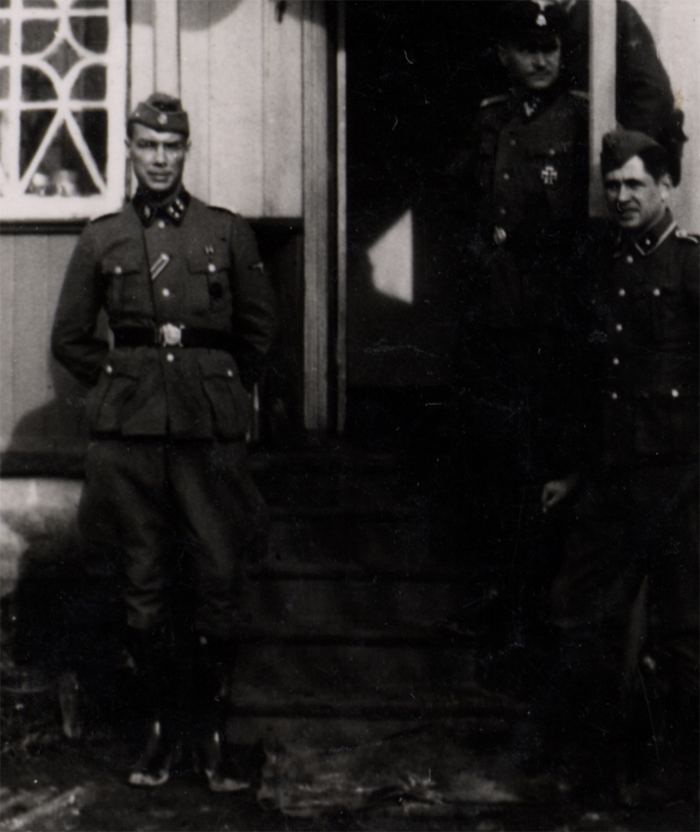 0
0 -
Getting back to basics. This is a pre-1900 French Colonial Medal with the pre-1900 Paris Mint Cornucopia and ARGENT hallmarks on the rim. The suspension bar or bellière is the Mercier type and has been hallmarked twice. The ALGERIE clasp. The clapette clasp is also by Mercier and bears the boar's head and company hallmarks. This time capsule item has its original full length riband complete with “award” prongs. This medal is in superb condition and seems never to have been worn. It is hard to find 115-year-old French medals in this condition and one can only assume that it might have been sent posthumously to the recipient's family.
 1
1 -
The price "3.75", presumably Reichmark, written in indelible pencil can still be seen on the reverse. The case is a classic Paul Meybauer Berlin-marked exemple but I think it's a shotgun wedding.
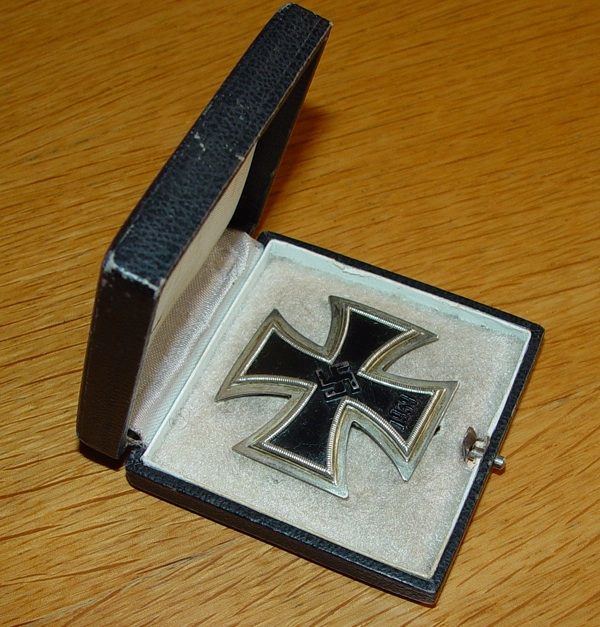 0
0 -
The price "3.75", presumably Reichmark, written in indelible pencil can still be seen on the reverse. The case is a classic Paul Meybauer Berlin-marked exemple but I think it's a shotgun wedding.
0 -
I know it predates the express outlawing of vaulted versions of the 1939 EK1 and I am aware of the story that some of the men from Assault Group Koch at Eben Emael were given vaulted EK1 as award pieces but can any of you tell me who made this cross? It came in a Paul Meybauer case but I don't think it's a Meybauer piece. The centre is iron and the frame appears to be neusilber or "German Silver", with what seems to be a real silver pin. A rarely seen type of cross.
 0
0 -
Members of II./FJR1 watch the humiliation of Jews in Poland in 1939. This snapshot came from a small lot of photos that belonged to a former Heer paratrooper who was transferred to the Luftwaffe with the rest of the Fallschirm-Infanterie-Bataillon. As many of the officers and NOCs of II./FJR1 still had their Heer uniforms at this stage, it is hard to tell from this photo if personnel from units other than II./FJR1 are involved. The young man partially obscured by the woman appears in several books.
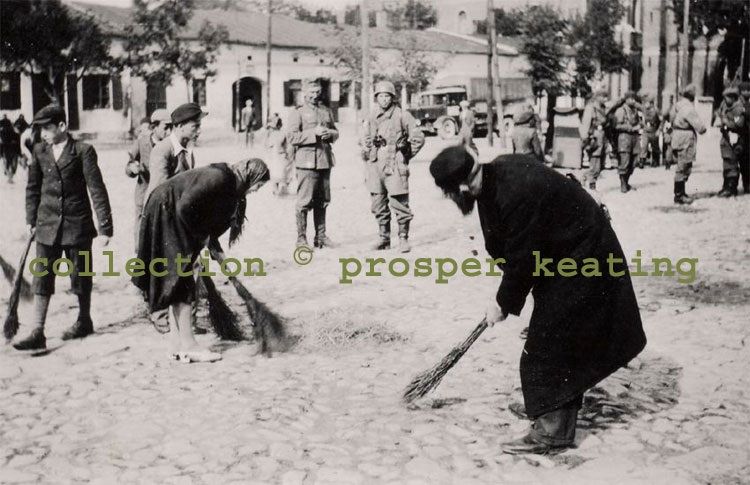 0
0 -
Cody
It is an amazing and yet as you say somewhat chilling helmet.
As much as I would welcome a DD WSS helmet in my collection I just don't know if I could have one of this pedigree. The Dachau part of it's history is just maybe too much for me.
Hope to see many more of your fine helmet collection grace these screens.
Rich
Dachau was a large complex of which the concentration camp, forced labour barracks and penal facility were actually fairly small parts. It is unlikely that this helmet ever saw the inside of the concentration camp. It was probably held as part of training staff stores. It may have been worn by guards on ceremonial duties in nearby Munich, especially given its previous black incarnation. Cody, I presume the liner shows traces of the black spray-over typical of all black Allgemeine-SS M35s. I believe the black versions were simply green M35s given a couple of coats of black gloss by the lads in the motor transport and maintenance sections, according to a third-hand veteran anecdote. No need to see it as a grisly Holocaust relic, anymore than the insignia and uniforms liberated by GIs from Dachau or, for that matter, the handful of SS-pattern parachutist smocks intended for SS-Fallschirmjäger and Jagdverbände units but never issued.
PK
0 -
Thank you very much for the information, Paul!
Prosper
0 -
Thanks for posting this, Jef. I think that today, they might have chosen the really ugly designs on the left, saying that the classic design on the right was too warlike and macho...
PK
0 -
Reverse
 0
0 -
One of the prettier commemorative medals struck for French veterans.
 0
0 -
Not sure how prestigious it is now, given that any 'businessman' can get himself appointed Chévalier de la Légion d'Honneur by getting a couple of members to second him and by sending "une valise" to the right people. I'd say that nomination to the Ordre des Arts & Lettres is probably more meaningful nowadays. Membership of that order has to be earned whereas the LdH is pretty much for sale nowadays, as long as the establishment sees you as useful. And when I see a veteran with the ribbons of the Croix de la Valeur Militaire, Croix de Guerre or Médaille Militaire (in the case of former NCOs) on their jackets, it means far more than that red ribbon. Unless one can be sure that the person earned it by doing something very special. Otherwise, it's just a badge for corrupt businessmen. In Arnie's case, good luck to him but, actually, what has he done for France, apart from running buying an occasional drink in Cannes after the courtesy bar runs dry?
PK
0 -
Anyone noticed the EIIR crown?
PK
0 -
Looks Masonic to me. I think we have a few Masons here who might be able to ID it for you.
0 -
Here's a 5th (US) Army version. It's actually for the entry into Naples.
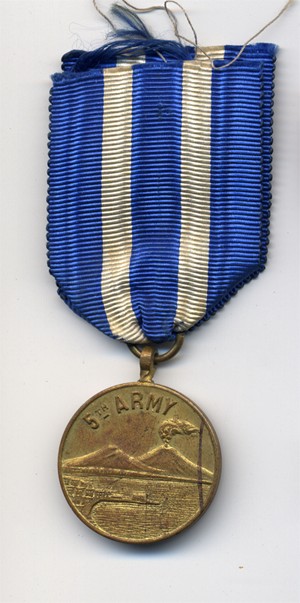 0
0 -
You are welcome. If you click on this link - http://www.cpaphil.com/images//QDK/QDK079.jpg you can find a scan of a postcard dating from 1913 showing a portrait photographed at Troubille on the Normandy coast of one Frédéric Postel, decorated with thirty-two «médailles de sauvetage» as well as the insignia of the Légion d'Honneur. Right in the middle of his chest seems to be the Croix des sauveteurs de Belfort. Note the large suspension ring. There would have been several makers of some of these medals over the years. A spelling error in "honneur" seems strange but it would not be the first time a die engraver made a mistake. There are some good French medal forums - whose members come here sometimes - where there must be someone who can offer you a more definitive opinion.
PK
 0
0 -
You are welcome. If you click on this link, you can find a scan of a postcard dating from 1913 showing a portrait photographed at Trouville on the Normandy coast of one Frédéric Postel, decorated with thirty-two «médailles de sauvetage» as well as the insignia of the Légion d'Honneur. Right in the middle of his chest seems to be the Croix des sauveteurs de Belfort. Note the large suspension ring. There would have been several makers of some of these medals over the years. A spelling error in "honneur" seems strange but it would not be the first time a die engraver made a mistake. There are some good French medal forums - whose members come here sometimes - where there must be someone who can offer you a more definitive opinion.
PK
0 -
This looks like the Croix des Sauveteurs du Haut-Rhin et du Territoire de Belfort from the 1870/71 period. The semi-official and unoffical life-saving awards of the 1870 period can command high prices amongst French collectors and some of these awards are faked. It might be genuine, despite the spelling error. It would be necessary to show this to an experienced collector. I found this image on http://semon.fr/LES%20MEDAILLES%20DE%20SAUVETAGE_3.htm. Look also at http://semon.fr/LES%20MEDAILLES%20DE%20SAUVETAGE_2.htm
Interesting site.
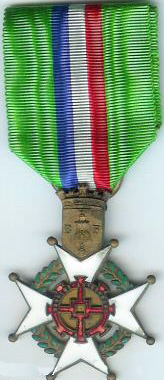 0
0 -
The Free French parachute battalions certainly wore British badges with the "dog and basket" removed but I am afraid that this is not a WW2-era example. This is a recent converted restrike or a copy of the British badge. It is worth perhaps £5.00.
PK
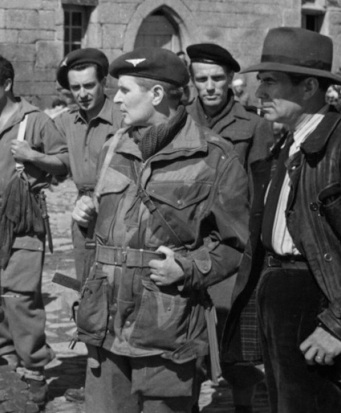 0
0 -
Do you mean the Prague Bar or just the ribbon bar?
Thanks,
PK
0 -
I didn't know that his adoptive brother - two boys adopted or fostered by the same family - won the George Cross. The story of climbing out onto the wing has always amazed me. Thank you for posting this link. I have been reading some of the other obituaries. I wrote an obituary for The Daily Telegraph once. It was of the Australian engineer Phil Irving MBE, the only man to design a world record-breaking motorcar and motorcycle. I wonder if I can find it on that website.
PK
0 -
That is a wide-ranging question. He was quite a personality and there is a lot of information on him. I met him a couple of times. The Wikipedia entry for him is a reasonably good place to start: http://en.wikipedia.org/wiki/Rudolf_Witzig. There is a lot of information. It depends on how much detail you need to go into. There are so many internet and book references. Do a Google search and you'll find all sorts of things: http://www.amazon.com/HITLERS-PARATROOPER-Battles-Rudolf-Witzig/dp/1848325592
PK
0 -
Medal and case are OK. The 'charm' fastened to the ribbon might conceivably be period but I doubt it. It's not a very 'German' thing to do. How much did it sell for?
PK
0 -
I had a bit of time in hand before dinner so I thought I would nose about. FP Nr 14 777 was used by 50. Infanterie-Division. My reference is a bit ambiguous but it may have been the Divisional HQ FPN. 50. ID participated in Barbarossa, fighting in the southern sector as part of 11. Armee. The division fought in the Crimea in 1941 and 1942 and was present at the fall of Sevastopol before seeing action in the Caucasus and the Kuban. Back in the Crimea in 1943, 50. ID was effectively destroyed at Sevastopol in May 1944. It was reformed and posted to East Prussia, was destroyed for the second time in the Heiligenbeil pocket.
Born in January 1924, Lechler would have been seventeen or eighteen during the qualifying period for the 1941/42 Winter War Medal and the Krim Shield. Being in the southern sector, the Romanian medal is also possible. He is listed as killed or missing in Seerappen, East Prussia, on 4.4.1945. Seerappen, now renamed, was in the Heiligenbeil pocket. There had been a Luftwaffe base there, from which KG 200 operated for a time. This was turned into a concentration camp, as part of the Stutthof complex. However, it was evacuated on 20.1.1945. So it is unlikely that young Lechler met his end before a firing squad there.
It is interesting, on the other hand, that he died in 50. ID's area of operations. It suggests he returned or was returned to his unit. The Red Army captured Seerappen, along with more than sixty villages on the Samland Penninsula, on 14.4.1945. So how did Lechler die? There are many possibilities. The wanted poster describes him as wandering about from east to west searching for his unit. If the EK1 and the Silver Wound Badge – and the other awards - were genuine, perhaps he had received a head wound, which was taken into account, along with his sterling military service and the fact that he had clearly volunteered when very young. Maybe he was deemed temporarily insane. On the other hand, wearing military awards to which one was unentitled was a serious offence in the Wehrmacht. So was desertion. Maybe he was simply arrested and sent back to 50. ID, where they stood him before a firing squad and shot him, ten days before the Soviets arrived. But this seems unlikely. He would have been sent to a military prison and shot there. Or to a penal unit. Or perhaps he was killed by bombing or strafing.
0




SS-Rgt "Deutschland" bei Prag 1938
in Germany: Third Reich: Research, Documentation & Photographs
Posted
Another of the images from a group of photos that belonged to a veteran of the SS-VT Standarte "Deutschland". The good-humoured young men in this snapshot seem to be on the march towards Prague. Discernable are the runic '1' collar patches, the D monograms on shoulder straps as well as camouflage ponchos and helmet covers in what seems to be platanenmuster or 'plane tree' pattern, first introduced in 1937. The officer at the front is still wearing his cross-strap as is his mounted colleague.